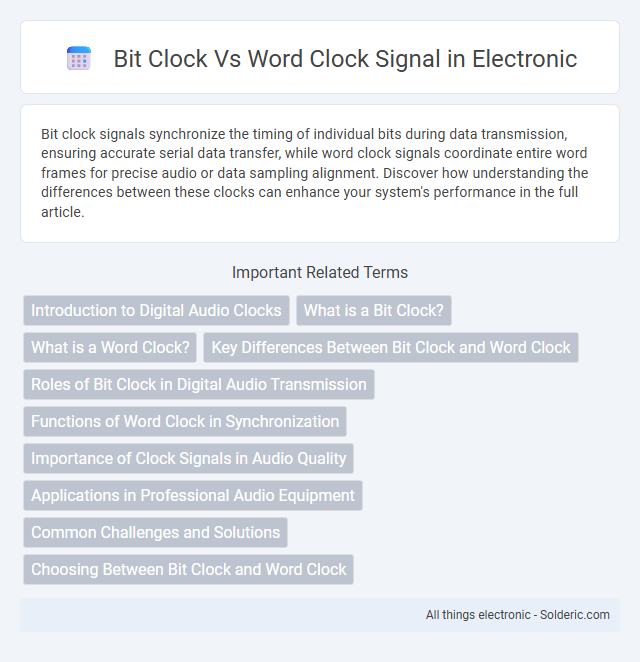Bit clock signals synchronize the timing of individual bits during data transmission, ensuring accurate serial data transfer, while word clock signals coordinate entire word frames for precise audio or data sampling alignment. Discover how understanding the differences between these clocks can enhance your system's performance in the full article.
Comparison Table
| Feature | Bit Clock | Word Clock |
|---|---|---|
| Definition | Clock signal synchronizing individual data bits | Clock signal synchronizing entire data words or frames |
| Frequency | Higher frequency, multiples of word rate (e.g., bit rate) | Lower frequency, matches word/frame rate |
| Purpose | Coordinates timing for each bit during transmission | Marks boundaries between consecutive data words/frames |
| Use Case | Common in serial audio interfaces (e.g., I2S) | Common in digital audio and professional synchronization |
| Signal Characteristics | Continuous toggling at bit rate | Pulse or square wave at word/frame intervals |
| Role in Data Transfer | Controls bit-level data timing | Controls word/frame alignment |
Introduction to Digital Audio Clocks
Digital audio clocks, including bit clock and word clock signals, play a crucial role in synchronizing audio data transmission. The bit clock controls the timing for each individual bit during serial audio data transfer, while the word clock ensures alignment of entire audio frames or words across multiple devices. Proper synchronization using these clocks prevents audio glitches and maintains data integrity in digital audio systems.
What is a Bit Clock?
A Bit Clock is a timing signal used in digital audio interfaces such as I2S to synchronize the transmission of individual bits within a serial data stream. It controls the pace at which bits are sent, ensuring precise alignment between the transmitter and receiver. Unlike a Word Clock, which signals the start of a complete audio frame, the Bit Clock operates at a higher frequency corresponding to each bit in the audio data.
What is a Word Clock?
A Word Clock is a synchronization signal used in digital audio systems to ensure all devices process audio data at the same sample rate, preventing timing errors and audio glitches. It coordinates the timing of audio word frames across multiple digital devices, maintaining audio fidelity in multi-channel or multi-device setups. Your digital audio equipment relies on Word Clock signals to achieve precise sample alignment, crucial for professional studio environments.
Key Differences Between Bit Clock and Word Clock
Bit clock signals control the timing for each individual bit transmitted in a digital audio stream, ensuring proper synchronization of the serial data bits. Word clock signals operate at a lower frequency, defining the start of each audio word or sample, aligning the entire frame of bits for accurate sample timing. The primary difference lies in their frequencies and roles: bit clock governs bit-level data transfer, while word clock ensures sample-level synchronization across digital audio devices.
Roles of Bit Clock in Digital Audio Transmission
Bit clock in digital audio transmission synchronizes the timing of each individual bit sent over the interface, ensuring precise data alignment and preventing corruption during transfer. It dictates the rate at which bits are transmitted, directly impacting audio quality and the reliability of synchronization between devices. Your audio system depends on the bit clock to maintain accurate and consistent timing for seamless digital audio playback and recording.
Functions of Word Clock in Synchronization
Word clock signals serve as a critical timing reference in digital audio systems, ensuring precise synchronization between multiple audio devices. By providing a consistent pulse that aligns the beginning of each audio sample frame, word clocks prevent timing mismatches and data corruption during digital audio transfer. This synchronization function is essential for maintaining audio integrity across mixers, converters, and digital interfaces in professional recording and live sound environments.
Importance of Clock Signals in Audio Quality
Clock signals such as bit clock and word clock are crucial in digital audio systems for maintaining precise timing and synchronization, directly impacting audio quality by reducing jitter and ensuring accurate data transmission. The bit clock synchronizes the transfer of individual bits in the audio stream, while the word clock synchronizes entire audio sample frames across multiple devices, preventing timing discrepancies. Proper alignment of these clock signals minimizes audio artifacts and preserves the integrity of the sound during recording, mixing, and playback processes.
Applications in Professional Audio Equipment
Bit clock and word clock signals are essential in professional audio equipment to ensure accurate data synchronization during digital audio transmission. Bit clock controls the timing of individual bits, while word clock synchronizes entire audio words or sample frames, minimizing jitter and maintaining signal integrity in multi-device setups such as digital mixers, DAWs, and audio interfaces. Your audio system's performance and audio fidelity heavily depend on the precise coordination enabled by these clock signals in studio and live sound environments.
Common Challenges and Solutions
Bit clock and word clock signals often face synchronization challenges due to jitter and latency, impacting audio quality and timing accuracy. Implementing high-quality clock generators and using phase-locked loops (PLLs) can significantly reduce jitter and maintain signal integrity. Proper cable shielding and minimizing cable length also help prevent electromagnetic interference, ensuring stable clock signal transmission.
Choosing Between Bit Clock and Word Clock
Choosing between bit clock and word clock signals depends on the specific audio synchronization requirements of your digital audio system. Bit clock signals govern the timing of individual data bits during digital audio transmission, ensuring precise bit-level synchronization, while word clock signals synchronize entire audio sample frames, maintaining alignment across multiple audio channels in professional setups. Selecting word clock is ideal for multi-channel or multi-device environments requiring consistent sample accuracy, whereas bit clock suffices for simpler, single-stream digital audio interfaces.
Bit clock vs word clock signal Infographic

 solderic.com
solderic.com